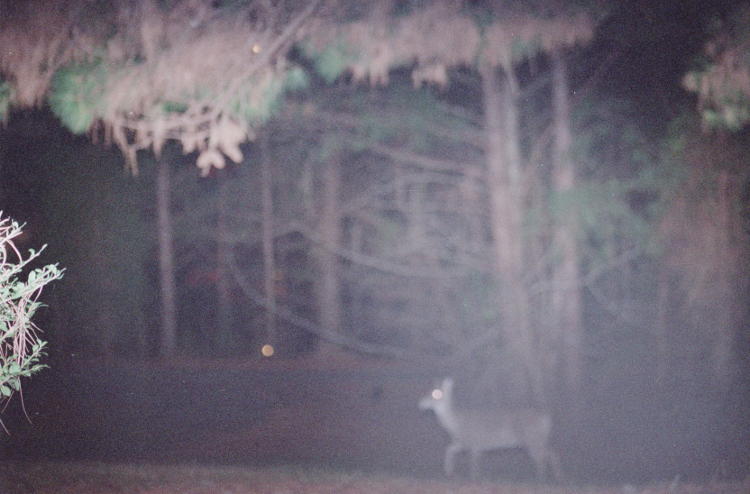
This… is not a good photo. I know that; with my years of experience, I can spot this through all the little telltales. And there’s a story behind it.
Not long after having moved back into North Carolina, I was living in a small duplex in the woods on the edge of two ponds – pretty nice locale for a nature photographer, except the apartment was too expensive for the sparse amenities, and the ponds were abruptly posted with No Trespassing signs a few months after I’d moved in, so I decided not to renew my lease. But while there, I would frequently see evidence of nocturnal visits, and occasionally spot a few myself – just barely, anyway. The hills around the ponds blocked out most of the urban light pollution and there were few lights nearby, so the environs got dark. (As an example, one night I walked the longish hike up to my mailbox since I’d forgotten to check the mail while driving in, and actually walked past the mailbox without realizing it, having to backtrack and count the boxes off by hand to determine which was mine. And I have good night vision.) Knowing that several different species were cutting across the lawn right outside of my living room window, I decided that I needed to try my first camera trap.
If you’re not familiar with the term, a camera trap is where you set up a camera in an ideal location to be triggered remotely when something interesting is within sight – sometimes automatically, with a motion-detector, or sometimes manually with a remote cord. In this case, I set up in my living room window, but had one on-camera flash unit and a more powerful one down in the yard, a lot closer to the areas most-frequented by wildlife, to be triggered by a slave foot that would detect the light burst from the first flash. I sat in a completely dark living room behind the camera and waited for activity – granted, this was not exactly a remotely-triggered camera, but the second flash was at least.
The first issue were my cats, because I’d opened the window and removed the screen for a clear view, which meant they were unhindered from getting outside; they were strictly indoor cats and were not allowed out, so the open window intrigued them and made me keep chasing them off, as silently as possible. Ben, especially, thought the window was irresistible, and wasn’t impressed with the nudges and whispered scolding he was receiving.
The second issue, as you might have spotted if you were sharp-eyed, was the focus. When a couple of white-tailed deer (Odocoileus virginianus) made their appearance, I realized that the viewfinder image through the Canon 75-300 I had affixed was waaayyy too dim to make out much of anything. Autofocus was already shut off of course, but manual focusing wasn’t going as smoothly as I’d hoped. My reasoning was, focus on the distant lights across the pond, then back off a bit and hope that I got fairly close to the mark, while watching whatever I might see in the viewfinder for cues.
Here’s what impressed me. I was sitting in an open window roughly fifteen meters from the deer, with whatever night noises were present. As I turned the focus ring, it made the barest scrape of plastic against plastic, little more than a hiss – and the first deer’s head snapped up immediately and looked right at me. Wickedly impressive hearing, as well as being much more alert to hazards than I would have thought in a species this close to people (there was a shopping plaza less than a kilometer away.) But as the deer started to move on, a little hastily it seemed, I fired off a single frame while one was still in view.
The lighting turned out to be pretty good overall, with the second flash triggering exactly as intended and illuminating the entire frame quite well. The light ahead of the deer is from a house on the other side of the pond, the point I’d used for the initial focus – but directly above it, in the tree, is something else, another critter’s eyes reflecting the flash. Proof of concept and viability, at least, and I vowed that, when I tried again, I’d post a couple of small reflectors at about the same distance as any likely subject, and focus on those ahead of time by flashlight.
Only, I never did try it again, anywhere, and about the closest I got was chasing some bats at night several years later. I really should make another attempt sometime soon.



















































